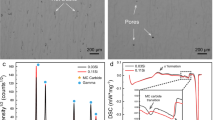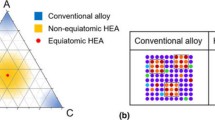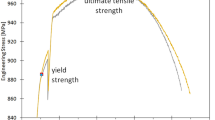Abstract
Additive manufacturing has risen to the top of research interest in advanced manufacturing in recent years due to process flexibility, achievability of geometric complexity, and the ability to locally modify and optimize materials. The present work is focused on providing an approach for incorporating thermodynamically consistent properties and microstructure evolution for non-equilibrium supercooling, as observed in additive manufacturing processes, into finite element analysis. There are two primary benefits of this work: (1) the resulting prediction is based on the material composition and (2) the nonlinear behavior caused by the thermodynamic properties of the material during the non-equilibrium solution is accounted for with extremely high resolution. The predicted temperature response and microstructure evolution for additively manufactured stainless steel 316L using standard handbook-obtained thermodynamic properties are compared with the thermodynamic properties calculated using the CALculation of PHAse Diagrams (CALPHAD) approach. Data transfer from the CALPHAD approach to finite element analysis is discussed.








Similar content being viewed by others
References
Amine T, Newkirk JW, Liou F (2014) An investigation of the effect of direct metal deposition parameters on the characteristics of the deposited layers. Case Stud Therm Eng 3:21–34. doi:10.1016/j.csite.2014.02.002. http://www.sciencedirect.com/science/article/pii/S2214157X14000070
Andersson JO, Helander T, Höglund L, Shi P, Sundman B (2002) Thermo-Calc & DICTRA, computational tools for materials science. Calphad 26(2):273–312. doi:10.1016/S0364-5916(02)00037-8
AZoM.com: AZO Materials: Stainless Steel - Grade 316 (UNS S31600) (2015). http://www.azom.com/properties.aspx?ArticleID=863
Borgenstam A, Höglund L, Ågren J, Engström A (2000) Dictra, a tool for simulation of diffusional transformations in alloys. J Ph Equilib 21(3):269–280. doi:10.1361/105497100770340057
Chang Y, Chen S, Zhang F, Yan X, Xie F, Schmid-Fetzer R, Oates W (2004) Phase diagram calculation: past, present and future. Prog Mater Sci 49(34):313–345. doi:10.1016/S0079-6425(03)00025-2. http://www.sciencedirect.com/science/article/pii/S0079642503000252
Chen Q, Sundman B (2002) Computation of partial equilibrium solidification with complete interstitial and negligible substitutional solute back diffusion. Mater Trans 43(3):551–559. doi:10.2320/matertrans.43.551
Dai K, Shaw L (2004) Thermal and mechanical finite element modeling of laser forming from metal and ceramic powders. Acta Mater 52(1):69–80. doi:10.1016/j.actamat.2003.08.028. http://www.sciencedirect.com/science/article/pii/S1359645403005081
Dinsdale A (1991) SGTE data for pure elements. Calphad 15(4):317–425. doi:10.1016/0364-5916(91)90030-N. http://www.sciencedirect.com/science/article/pii/036459169190030N
Foroozmehr A, Badrossamay M, Foroozmehr E, Golabi S (2016) Finite element simulation of selective laser melting process considering optical penetration depth of laser in powder bed. Mater Des 89:255–263. doi:10.1016/j.matdes.2015.10.002. http://www.sciencedirect.com/science/article/pii/S0264127515305803
Gulliver G (1913) The quantitative effect of rapid cooling upon the constitution of binary alloys. J Inst Met 9:120–157
Gusarov A, Smurov I (2010) Modeling the interaction of laser radiation with powder bed at selective laser melting. Phys Proced, vol 5, part B. In: Laser sssisted net shape engineering 6, proceedings of the LANE 2010, part 2, pp 381–394. doi:10.1016/j.phpro.2010.08.065. http://www.sciencedirect.com/science/article/pii/S1875389210004918
Gusarov AV, Yadroitsev I, Bertrand P, Smurov I (2009) Model of radiation and heat transfer in laser-powder interaction zone at selective laser melting. J Heat Transf 131(7):072101. doi:10.1115/1.3109245
Hillert M (1999) Solute drag, solute trapping and diffusional dissipation of gibbs energy. Acta Mater 47(18):4481–4505. doi:10.1016/S1359-6454(99)00336-5. http://www.sciencedirect.com/science/article/pii/S1359645499003365
Hillert M (2001) The compound energy formalism. J Alloys Compd 320(2):161–176. doi:10.1016/S0925-8388(00)01481-X
Kaufman L, Ågren J (2014) Calphad, first and second generation birth of the materials genome. Scr Mater 70:3–6. doi:10.1016/j.scriptamat.2012.12.003. http://www.sciencedirect.com/science/article/pii/S1359646212007749
King W, Anderson A, Ferencz R, Hodge N, Kamath C, Khairallah S (2015) Overview of modelling and simulation of metal powder bed fusion process at lawrence livermore national laboratory. Mater Sci Technol 31(8):957–968
Kitashima T (2008) Coupling of the phase-field and CALPHAD methods for predicting multicomponent, solid-state phase transformations. Philos Mag 88(11):1615–1637. doi:10.1080/14786430802243857
Li Q, Chen Y, Jiang Z (1985) Relationship between solidification thermal parameters and dendrite arm spacing and ultimate tensile strength in Al-Cu-Mm alloys. J Less Common Met 110(1):171–174. doi:10.1016/0022-5088(85)90318-2. http://www.sciencedirect.com/science/article/pii/0022508885903182
Manvatkar V, De A, DebRoy T (2015) Spatial variation of melt pool geometry, peak temperature and solidification parameters during laser assisted additive manufacturing process. Mater Sci Technol 31(8):924–930. doi:10.1179/1743284714Y.0000000701
Matsumoto M, Shiomi M, Osakada K, Abe F (2002) Finite element analysis of single layer forming on metallic powder bed in rapid prototyping by selective laser processing. Int J Mach Tools Manuf 42(1):61–67. doi:10.1016/S0890-6955(01)00093-1. http://www.sciencedirect.com/science/article/pii/S0890695501000931
Olson GB (2013) Genomic materials design: the ferrous frontier. Acta Mater 61(3):771–781. doi:10.1016/j.actamat.2012.10.045. http://www.sciencedirect.com/science/article/pii/S1359645412007926
Olson GB, Kuehmann CJ (2014) Materials genomics: from calphad to flight. Scr Mater 70:25–30. doi:10.1016/j.scriptamat.2013.08.032. http://www.sciencedirect.com/science/article/pii/S1359646213004375
Saunders N (2009) The application of thermodynamic and material property modeling to process simulation of industrial alloys, metals process simulation. In: Furrer DU, Semiatin SL (eds) ASM Handbook, Vol 22B. ASM International, Materials Park, pp 132–153
Schaffnit P, Stallybrass C, Konrad J, Stein F, Weinberg M (2015) A scheilgulliver model dedicated to the solidification of steel. Calphad 48:184–188. doi:10.1016/j.calphad.2015.01.002. http://www.sciencedirect.com/science/article/pii/S0364591615000036
Scheil E (1942) Bemerkungen zur schichtkristallbildung. Zeitschrift fuer Metallkunde 34:70–72
Smith J, Xiong W, Yan W, Lin S, Cheng P, Kafka OL, Wagner GJ, Cao J, Liu WK (2015) Linking process, structure, property, and performance for metal based additive manufacturing: computational approaches with experimental support. Comput Mech. doi:10.1007/s00466-015-1240-4
Tolochko NK, Arshinov MK, Gusarov AV, Titov VI, Laoui T, Froyen L (2003) Mechanisms of selective laser sintering and heat transfer in ti powder. Rapid Prototyp J 9(5):314–326. doi:10.1108/13552540310502211
Xiong W, Chen Q, Korzhavyi PA, Selleby M (2012) An improved magnetic model for thermodynamic modeling. Calphad 39:11–20. doi:10.1016/j.calphad.2012.07.002. http://www.sciencedirect.com/science/article/pii/S0364591612000612
Xiong W, Du Y, Hu RX, Wang J, Zhang WW, Nash P, Lu XG (2008) Construction of the Al–Ni–Si phase diagram over the whole composition and temperature ranges: thermodynamic modeling supported by key experiments and first-principles calculations. Int J Mater Res 99:598–612. Kolbergerstrasse 22, Munchen, D-81679. doi:10.3139/146.101681
Xiong W, Grönhagen KA, Ågren J, Selleby M, Odqvist J, Chen Q (2011) Investigation of spinodal decomposition in Fe–Cr alloys: CALPHAD modeling and phase field simulation, pp 1060–1065. http://dx.doi.org/10.4028/www.scientific.net/SSP.172-174.1060
Xiong W, Olson GB (2015) Integrated computational materials design for high-performance alloys. MRS Bull 40(12):1035–1044. doi:10.1557/mrs.2015.273. http://www.journals.cambridge.org/abstract_S0883769415002730
Yan W, Smith J, Ge W, Lin F, Liu W (2015) Multiscale modeling of electron beam and substrate interaction: a new heat source model. Comput Mech 52:1–12. doi:10.1007/s00466-015-1170-1
Yin J, Zhu H, Ke L, Hu P, He C, Zhang H, Zeng X (2015) A finite element model of thermal evolution in laser micro sintering. Int J Adv Manuf Technol, pp 1–13. doi:10.1007/s00170-015-7609-x
Zaeh M, Ott M (2011) Investigations on heat regulation of additive manufacturing processes for metal structures. CIRP Ann Manuf Technol 60(1):259–262. doi:10.1016/j.cirp.2011.03.109. http://www.sciencedirect.com/science/article/pii/S0007850611001107
Zäh M, Lutzmann S (2010) Modelling and simulation of electron beam melting. Prod Eng 4(1):15–23. doi:10.1007/s11740-009-0197-6
Zheng B, Zhou Y, Smugeresky JE, Schoenung JM, Lavernia EJ (2008) Thermal behavior and microstructure evolution during laser deposition with laser-engineered net shaping: part II. Experimental investigation and discussion. Metall Mater Trans A 39(9):2237–2245. doi:10.1007/s11661-008-9566-6
Acknowledgments
The authors would like to gratefully acknowledge the support for this work provided by National Institute of Standards and Technology (NIST) and Center for Hierarchical Materials Design (CHiMaD) under Grant No. 70NANB13Hl94 and 70NANB14H012. The first author would like to acknowledge the United States Department of Defense for their support through the National Defense Science and Engineering Graduate (NDSEG) fellowship award. Wei Xiong is grateful to the Thermo-Calc software company for providing the license to the software and databases used in this research.
Author information
Authors and Affiliations
Corresponding author
Rights and permissions
About this article
Cite this article
Smith, J., Xiong, W., Cao, J. et al. Thermodynamically consistent microstructure prediction of additively manufactured materials. Comput Mech 57, 359–370 (2016). https://doi.org/10.1007/s00466-015-1243-1
Received:
Accepted:
Published:
Issue Date:
DOI: https://doi.org/10.1007/s00466-015-1243-1




